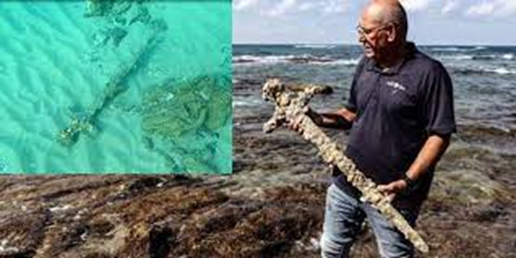Nájdený križiacky meč pripomína mnohé kostoly , ktoré postavili križiaci v Svätej zemi.
RITROVATA UNA SPADA CROCIATA CHE CI RICORDA LE TANTE CHIESE COSTRUITE IN TERRA SANTA DAI CAVALIERI
(La spada crociata ritrovata davanti al Monte Carmelo)
Qualche settimana fa la notizia di un ritrovamento archeologico nel mare di Israele, al largo della costa del Monte Carmelo, ha fatto il giro del mondo. Shlomi Katzin facendo immersioni ha trovato diversi antichi manufatti sul fondo del mare, apparentemente scoperti dalle onde e dalle correnti sotterranee che avevano spostato la sabbia. Il più significativo è una spada con una lama lunga un metro e un’elsa lunga 30 cm.
Le autorità delle antichità israeliane hanno riconosciuto una spada “conservata in perfette condizioni, è un reperto bello e raro ed evidentemente apparteneva a un cavaliere crociato“. La costa del Carmelo ha molte insenature naturali perfetto per riparare le navi dalle tempeste.
I crociati, cavalieri di cui si è scritto tra storia e leggende, quelli che andarono a liberare la Terra Santa dal dominio islamico dei luoghi santi, alcuni dei quali, come la basilica del Santo Sepolcro, erano stati quasi rasi al suolo nel 1009.
I crociati, tra i quali i cavalieri di San Lazzaro, erano non solo guerrieri ma grandi architetti, costruttori di castelli e di chiese. Alcuni costruite ex novo, altre ricostruite dopo le devastazioni magari su antiche vestigia bizantine.
Nel 1113 i cavalieri di San Giovanni, dai quali sarebbero nati, da lì a poco, i cavalieri di San Lazzaro, iniziarono la costruzione della chiesa latina dedicata al proprio santo tutelare a Beirut che, dopo la conquista saracena, divenne la grande moschea di Omar, ma ancora è evidente lo stile crociato. Anche a Tiro la cattedrale era stata costruita dai crociati ed era usata per l’incoronazione dei re latini di Gerusalemme quando, dopo la riconquista islamica della Città Santa, la capitale fu portata nella vicina Acri.
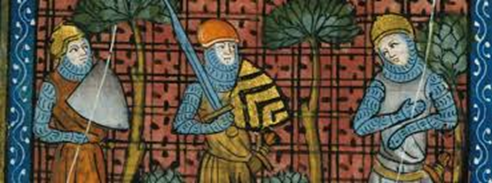
Acri recuperata dai cristiani dopo un lungo assedio dal 1189 al 1191, fu il più importante baluardo crociato in Terra Santa, l’ultimo a tornare, nel 1291, ai musulmani guidati dal sultano al Ashraf ed ebbe il ruolo di capitale del regno che ormai era solo una striscia di costa e il corridoio che permetteva l’arrivo al Santo Sepolcro.
I crociati avevano ad Acri un vero centro di accoglienza per i pellegrini, un castello con una chiesa a pianta ottagonale. A Cesarea all’interno della cinta muraria si trova, oggi tra le rovine, una chiesa a pianta basilicale. Anche questo edificio divenne moschea.
Se si arriva a Ramla, lasciando la costa, la grande moschea di Jami el Kebir altro non è che la cattedrale cristiana dedicata a San Giovanni, il santo prediletto dai cavalieri d’oltremare.
A Sebaste, oggi Sebastiya, nel 1165 venne costruita una chiesa dedicata a San Giovanni Battista, impiantata sulle rovine di un preesistente luogo di culto bizantino, una basilica a tre navate. L’architettura è ormai segnata dal gotico ancora riconoscibile nonostante il riuso come moschea.
Nel cammino verso Gerusalemme si incontra anche un monastero, Abu Gosh, che fu costruito dai crociati su una preesistente cisterna romana. La chiesa conventuale è stata assegnata nel XIX secolo allo stato francese e gestita dall’ordine benedettino di Monte Oliveto.
Interessante la storia degli affreschi romanici abbandonati dai musulmani che ridussero il locale a stalla e che sono stati pazientemente restaurati, con diversi episodi biblici.
A Gerusalemme i cavalieri costruirono moltissimi edifici, ma ovviamente l’edificio più significativo è il complesso del Santo Sepolcro.
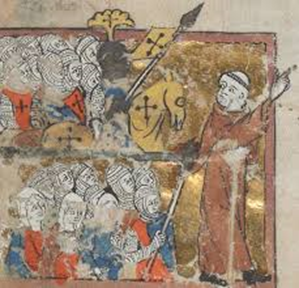
Gerusalemme custodisce anche un altro gioiello crociato che ancora è una chiesa: Sant’Anna. Perfettamente conservata anche grazie al fatto che venne donata a Napoleone III dai sultani per l’aiuto avuto nella guerra in Crimea, oggi è gestita dai Padri d’Africa.
Altro luogo simbolo è il Cenacolo, un’ampia aula rettangolare che i crociati ricavarono nel XIII secolo su un precedente luogo di culto di epoca romana. Da non dimenticare la Cappella dell’Ascensione.
La riconquista musulmana portò al riuso di molte strutture anche nei castelli dove, essendo i crociati parte di ordini monastico cavallereschi, grande spazio avevano aule e cappelle che richiamavano le proporzioni del Tempio di Gerusalemme.
E quello che i crociati avevano imparato costruendo in Medio Oriente con cognizioni latine, lo riportarono in Europa diffondendo nella costruzione delle cattedrali gotiche una nuova scienza costruttiva.
Quasi tutte le chiese che i crociati lasciarono in Terra Santa furono convertite in moschee dopo la riconquista saracena, ma conservano la struttura originale tutta latina e cristiana.
A CRUSADER SWORD REDISCOVERED, REMINDING US OF THE MANY CHURCHES BUILT IN THE HOLY LAND BY THE KNIGHTS
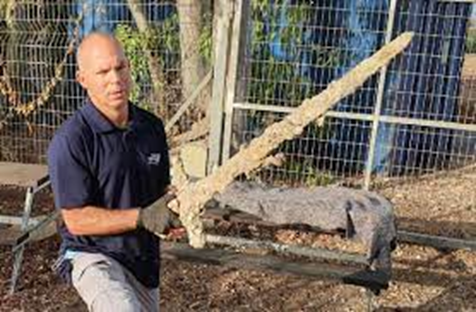
(The rediscovered crusader sword )
A few weeks ago, news of an archaeological find in the Israeli sea, off the coast of Mount Carmel, went around the world. While diving, Shlomi Katzin found several ancient artefacts at the bottom of the sea, apparently discovered by waves and underground currents that had shifted the sand. The most significant is a sword with a one-metre long blade and a 30 cm long hilt.
The Israeli antiquities authorities recognised a sword ‚preserved in perfect condition, it is a beautiful and rare find and evidently belonged to a crusader knight‘. The Carmel coast has many natural inlets perfect for sheltering ships from storms.
The crusaders, knights of whom history and legends have been written about, were the ones who went to liberate the Holy Land from Islamic rule of the holy places, some of which, like the basilica of the Holy Sepulchre, had been almost razed to the ground in 1009.
The crusaders, including the Knights of St Lazarus, were not only warriors but also great architects, builders of castles and churches. Some built from scratch, others rebuilt after the devastation, perhaps on top of ancient Byzantine remains.
In 1113, the Knights of St John, from whom the Knights of St Lazarus would shortly be born, began construction of the Latin church dedicated to their patron saint in Beirut which, after the Saracen conquest, became the great mosque of Omar, but the Crusader style is still evident. The cathedral in Tyre was also built by the Crusaders and was used for the coronation of the Latin kings of Jerusalem when, after the Islamic reconquest of the Holy City, the capital was taken to nearby Acre.
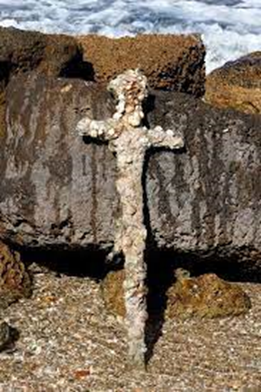
Acre, recovered by the Christians after a long siege from 1189 to 1191, was the most important Crusader bulwark in the Holy Land, the last to return, in 1291, to the Muslims led by Sultan al Ashraf, and had the role of capital of the kingdom, which by then was only a strip of coastline and the corridor leading to the Holy Sepulchre.
The Crusaders had in Acre a true reception centre for pilgrims, a castle with an octagonal church. In Caesarea, within the city walls, there is a church with a basilica layout, now in ruins. This building also became a mosque.
If you get to Ramla, leaving the coast, the great mosque of Jami el Kebir is none other than the Christian cathedral dedicated to St John, the favourite saint of the overseas knights.
In Sebaste, now Sebastiya, a church dedicated to St John the Baptist was built in 1165 on the ruins of a pre-existing Byzantine place of worship, a three-nave basilica. The architecture is now marked by the still recognisable Gothic style despite its reuse as a mosque.
On the way to Jerusalem we also come across a monastery, Abu Gosh, which was built by the Crusaders on a pre-existing Roman cistern. The monastery church was assigned to the French state in the 19th century and run by the Benedictine order of Monte Oliveto.
There is an interesting history of Romanesque frescoes abandoned by the Muslims who reduced the place to a stable and which have been patiently restored, depicting various biblical episodes.
In Jerusalem, the Knights built many buildings, but obviously the most significant building is the Holy Sepulchre complex.
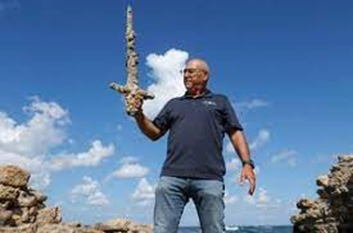
Jerusalem is also home to another Crusader jewel that is still a church: St Anne’s. Perfectly preserved, thanks in part to the fact that the church is still a church. Perfectly preserved, thanks also to the fact that it was donated to Napoleon III by the sultans for his help in the Crimean war, it is now run by the Fathers of Africa.
Another symbolic place is the Cenacle, a wide rectangular hall that the crusaders built in the 13th century on a previous place of worship from the Roman era. Don’t forget the Chapel of the Ascension.
The Muslim reconquest led to the reuse of many structures even in the castles where, as the Crusaders were part of monastic orders of chivalry, great space was given to halls and chapels that recalled the proportions of the Temple of Jerusalem.
And what the Crusaders had learnt by building in the Middle East with Latin knowledge, they brought back to Europe, spreading a new construction science in the construction of Gothic cathedrals.
Almost all the churches that the Crusaders left behind in the Holy Land were converted into mosques after the Saracen reconquest, but they retain their original Latin and Christian structure.
UDALOSTI
- Grand Hospitaller Report 2023 27. júna 2024
- Podpora vzdelávacieho procesu na školách 7. júna 2024
- Investitúra 2024 25. mája 2024
- Pozvánka na investitúru 2024 17. mája 2024
- Charitatívna činnosť 15. mája 2024
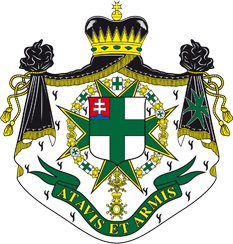
 Military and Hospitaller Order of St.Lazarus of Jerusalem Grand Priory Slovakia,
Military and Hospitaller Order of St.Lazarus of Jerusalem Grand Priory Slovakia,